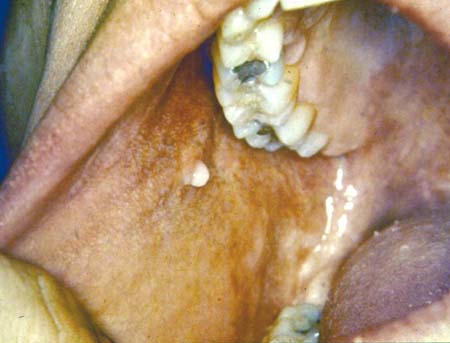History and exam
Key diagnostic factors
common
fever
May accompany an acute infective sialadenitis or autoimmune aetiology suggestive of infection or inflammation.
pain and dysphagia
New onset of pain and swelling, usually unilateral, affecting the parotid or submandibular regions. Pain may be worse on eating and swallowing.[31]
facial swelling
Usually unilateral and typically over the parotid region, under the tongue, or below the jaw. Patient may have acute onset and may have had repeated episodes in the past.[31][Figure caption and citation for the preceding image starts]: Acute bacterial sialadenitis of left parotid glandFrom the personal collection of Dr A. Aguirre; used with permission [Citation ends].
recurrent painful swellings
Suggest chronic recurrent sialadenitis. Each episode may have similar symptoms and signs to an acute episode.
exudates of pus from salivary gland opening
Indicative of bacterial infection. May occur spontaneously or on manipulation of the gland. Stensen's duct drains the parotid gland opposite the upper second molar tooth. Wharton's duct drains into the sublingual papillae.[Figure caption and citation for the preceding image starts]: Intra-oral view of right parotid gland showing purulent exudate exiting Stensen's ductFrom the personal collection of Dr A. Aguirre; used with permission [Citation ends].
use of xerostomic medications
Decreased salivary flow rate can predispose to infection. Medications that may contribute include antihistamines, antidepressants, and anticholinergic agents.[39]
uncommon
mandibular trismus
Inability to open the mouth to full extent (about 40 mm). May be present with large swellings typically of acute bacterial origin.
respiratory distress (stridor, use of accessory muscles, nasal flaring, wheeze)
Signs may develop if glandular swelling is significant and causes airway obstruction.[31] Although it is uncommon, it must be recognised and managed promptly.
cranial nerve palsy
Cranial nerves VII (facial), IX (glossopharyngeal), and XII (hypoglossal) are at risk of compression from swelling. The facial nerve (VII) traverses the parotid gland and splits into its constituent branches within the substance of the parotid itself.
connective tissue disorder or Sjogren syndrome
May have a history of Sjogren syndrome or a concomitant connective tissue disease (e.g., systemic lupus erythematosus, rheumatoid arthritis, or scleroderma).
Other diagnostic factors
common
episodic swelling during eating
Acute salivary gland swelling without observable flow of saliva from the ductal orifices. Palpation may reveal an indurated salivary gland and the presence of a sialolith.
recent surgical intervention under general anaesthetic
Predisposes to sialadenitis through direct effects of anaesthetic agents and volume depletion from surgery.
dry eyes and mouth
Dryness of the oral cavity and eyes are key symptoms of Sjogren syndrome and may be seen in combination with a connective tissue disease (e.g., rheumatoid arthritis, dermatomyositis, or scleroderma).
oral candidiasis
May be present in Sjogren syndrome or in association with connective tissue disorders.
iodine contrast exposure
Acute iodide sialadenitis, or 'iodide mumps', is a rare adverse reaction to iodinated contrast causing salivary gland swelling. The condition may be underdiagnosed, with researchers postulating that its true incidence may be close to 1% to 2%.
uncommon
recurrent painless swellings
May indicate underlying autoimmune aetiology.[Figure caption and citation for the preceding image starts]: Bilateral swelling of parotid glands in Sjogren's syndromeFrom the personal collection of Dr A. Aguirre; used with permission [Citation ends].
displacement of earlobe
May occur with swelling of the parotid gland.
prodrome of tingling in the affected gland
May precede pain and swelling in chronic recurrent sialadenitis.
swelling on the hard palate
A rare inflammatory condition, usually painful and affecting the posterior part of the hard palate. May be unilateral or bilateral. Usually of sudden onset.[40]
Risk factors
strong
volume depletion and malnutrition
immunosuppression
Sjogren syndrome
Autoimmune sialadenitis is associated with Sjogren syndrome.[13]
connective tissue diseases
Associated with autoimmune sialadenitis, although aetiology is unclear.[28]
women aged 50 to 60
Sjogren syndrome is most common in peri- and post-menopausal women.[3]
general anaesthesia
Nosocomial sialadenitis may occur up to a few weeks following surgery. In 1 series of 161 patients, one third had undergone surgery in the preceding weeks, although many also had significant comorbidities.[24]
xerostomic medications
A number of drugs (e.g., diuretics, antihistamines, antidepressants, antihypertensive medication) may produce pharmacologically induced salivary gland hypofunction.[20]
sialolithiasis
Chronic sclerosing sialadenitis may result from obstruction of salivary glands by microliths and may be an IgG4 associated disease.[29]
chronic mechanical obstruction and/or multiple bouts of acute inflammation
Microlithiasis, recurrent infections, and putative immunological destruction of acini lead to the development of chronic sclerosing sialadenitis of major salivary glands.[13]
Use of this content is subject to our disclaimer